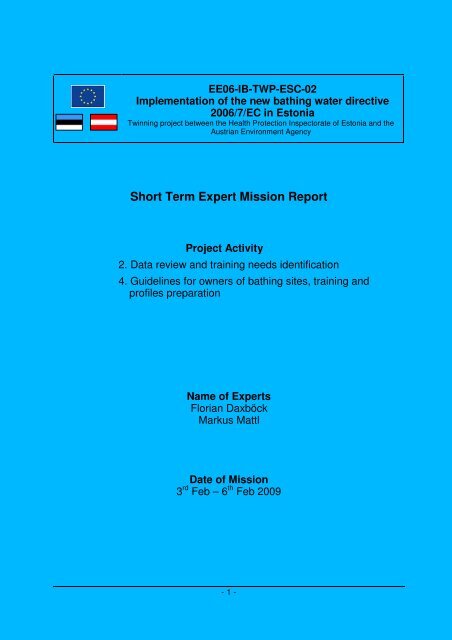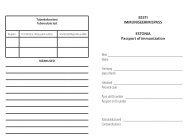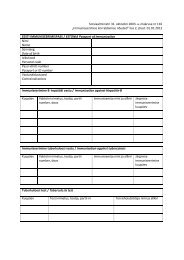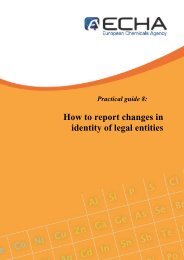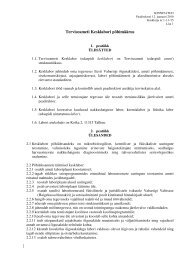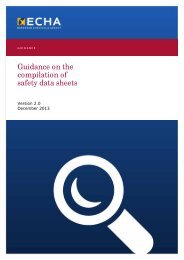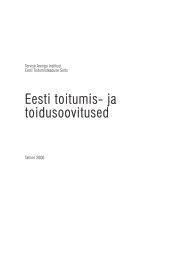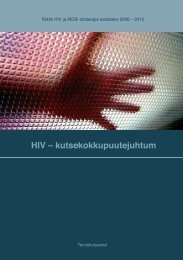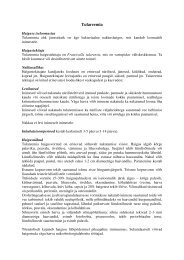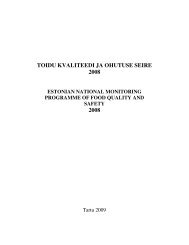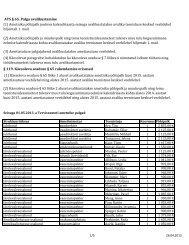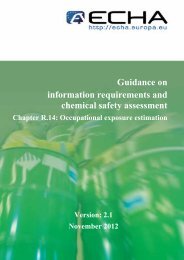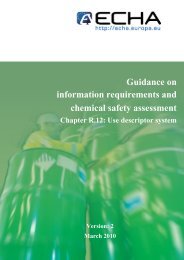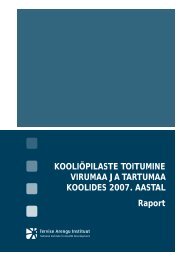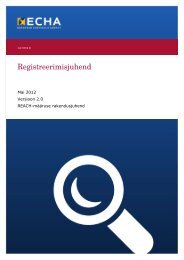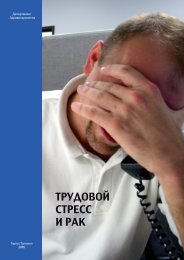Short Term Expert Mission Report - Terviseamet
Short Term Expert Mission Report - Terviseamet
Short Term Expert Mission Report - Terviseamet
Create successful ePaper yourself
Turn your PDF publications into a flip-book with our unique Google optimized e-Paper software.
EE06-IB-TWP-ESC-02Implementation of the new bathing water directive2006/7/EC in EstoniaTwinning project between the Health Protection Inspectorate of Estonia and theAustrian Environment Agency<strong>Short</strong> <strong>Term</strong> <strong>Expert</strong> <strong>Mission</strong> <strong>Report</strong>Project Activity2. Data review and training needs identification4. Guidelines for owners of bathing sites, training andprofiles preparationName of <strong>Expert</strong>sFlorian DaxböckMarkus MattlDate of <strong>Mission</strong>3 rd Feb – 6 th Feb 2009- 1 -
EE05-IB-TWP-ESC-02 STE <strong>Mission</strong> <strong>Report</strong> 3 rd Feb – 6 th Feb 2009Table of Content1. Background to the <strong>Mission</strong> ..................................................................... 42. Activities ................................................................................................. 53. Main Observations .................................................................................. 64. Next Steps and Recommendations ........................................................ 85. Annex...................................................................................................... 9- 2 -
EE05-IB-TWP-ESC-02 STE <strong>Mission</strong> <strong>Report</strong> 3 rd Feb – 6 th Feb 2009AbbreviationsBCHPIKKMITKMSPLPMSTEUBABeneficiary CountryEstonian Health Protection InspectorateEstonian Ministry of the EnvironmentEstonian Information and Technology CentreMember StateProject LeaderProject Manager<strong>Short</strong>-<strong>Term</strong> <strong>Expert</strong>Umweltbundesamt (Austrian Environmental Agency)- 3 -
EE05-IB-TWP-ESC-02 STE <strong>Mission</strong> <strong>Report</strong> 3 rd Feb – 6 th Feb 20091. Background to the <strong>Mission</strong>Estonian has invited European Union member states to participate in the TwinningLight project EE05-IB-TWP-ESC-02 which has the overall objective to minimisehealth risks caused by contaminated bathing waters and substandard bathing sites.The project purpose is to support Estonian government institution in theimplementation of the bathing water directive 2006/7/EC.In October 2008, the proposal from the Austrian Environment Agency was selectedby the Estonian counter partners. Following, the twinning contract was prepared bythe contracting authority and after signing the notification took place in December2008.At the beginning of February 2009, the kick-off meeting was carried out and thedetailed work plan was prepared.The main tasks of the first mission were the review of existing data which would benecessary to establish the bathing water profiles required by the directive 2006/7/EC,and to identify the specific training needs of health inspections specialists andowners of bathing sites in Estonia. In addition, the national legal framework forbathing water examination in Estonia, the recent microbiological data on bathingwater, and the respective laboratory resources should be reviewed.Participants<strong>Short</strong> <strong>Term</strong> <strong>Expert</strong>sMr. Florian DaxböckMr. Markus MattlBeneficiary Country <strong>Expert</strong>sEstonian Health Protection InspectorateMr. Jüri RuutMs. Leena AlbrehtMs. Aune AnnusMr. Mihhail MuzotsinMs. Ööle JansonMs. Imigolda BekergunMs. Inna SarvOther Estonian stakeholdersMr. Rene ReisnerMs. Karin PachelMr. Margus KorsjukovMs. Eda AndresmaaLocation and dateThe activities were carried out in Tallinn from 3 rd February to 6 th February 2009.- 4 -
EE05-IB-TWP-ESC-02 STE <strong>Mission</strong> <strong>Report</strong> 3 rd Feb – 6 th Feb 20092. ActivitiesBelow are the activities listed which were carried out by the STE during their mission:- Various meetings with counter partners from Estonian HPI central office wereheld- The HPI microbiological laboratory was visited by Mr Daxböck- A meeting about the water monitoring took place in the Estonian Informationand Technology Centre with participants from the Estonian Ministry ofEnvironment- Participation in the opening seminar- Discussion on the detailed project work plan and the main training needs- The structure of the guidelines for compiling bathing water profiles, healthinspectors and bathing site owners were drafted. (see annex)- Review of existing documentso “Acting guide for the toxic cyanobacterial blooms in bathing water” (HPI,2008)o Microbiological data and denominator data from 2008 bathing waterexaminationo Data which are available in ITK and were used for the purpose ofreporting under the WFDo Legal framework in Estonia (transposion of directive 2006/7/EC intoEstonian law): Regulation of the Government No 74 “Requirements forbathing water and bathing places” (03.04.2008)- 5 -
EE05-IB-TWP-ESC-02 STE <strong>Mission</strong> <strong>Report</strong> 3 rd Feb – 6 th Feb 20093. Main ObservationsDuring a visit at the ITK a presentation on data and information available on Estonianwater quality was given to the STE. The presented data were also used for thepurpose of reporting obligations under Article 5 of the WFD and are also important forthe river basin management plans. Still there is a lot of work ongoing as the riverbasin management plans still have to be finalised.Directive 2006/7/EC clearly indicates, that data and monitoring results fromassessments carried out pursuant to the water framework directive have to be usedadequately when establishing the bathing water profiles (see Article 6 of directive2006/7/EC).So far, Estonia has finalised the draft river basin management plans for all river basinsub districts. They are now being updated and are available on the internet. Thelanguage that they are written in is Estonian and a translation into English would beout of the twinning project scope. Therefore an assessment of the data by the STEwill not be possible.The STE also saw a presentation on the monitoring network in Estonia whichbasically covers lakes, rivers and coastal and open sea. There are permanentmonitoring sites and rotating monitoring sites. According to information given by theEstonian partners it would also be possible to place a rotating monitoring site in abathing water as bathing waters are regarded as “protected areas” under the WFD.From the visit at ITK and the discussion with participants from HPI, ITK and KKM itcame clear, that the data required for the compilation of the bathing water profiles arehosted in ITK. It also seems, that ITK disposes of the human capacity to assess andinterpret the data.From the first impressions gained from the presentations and discussion with the BCstaff it seems that the data used for all the reporting obligations under the WFD issufficient for the elaboration of the bathing water profiles.The detailed requirements on the data will be given by the output of the EC workinggroup “bathing water profiles” (which will have its plenary meeting from February 10 th -11 th 2009 in Brussels). Afterward a definition on the data and the requiredaggregation levels can be provided by the Austrian contractor as he itself is not ableto check the sufficiency alone because all the information is only available inEstonian language.Some basic questions concerning the processing of the data which will be necessaryfor the bathing water profiles will have to be clarified in the near future.• The first one is the question who will be responsible for the processing of thedata for the profiles,• the second one is the question on the responsibility of the assessment of theproliferation of cyanobacteria and phytoplankton.- 6 -
EE05-IB-TWP-ESC-02 STE <strong>Mission</strong> <strong>Report</strong> 3 rd Feb – 6 th Feb 2009The data needed for the assessment (mainly monitoring results on nutrients but alsoon oxygen, visible depth, etc.) is provided by ITK and KKM and also the allocation ofmonitoring sites is in the power of these two institutions.The question on who will be responsible for the processing of the data will probablydepend on the availability of general working resources as well as on the availabilityof certain specific working resources (e.g. the availability of a GIS system).The review of the microbiological data from the 2008 bathing season revealed wellaccessible data sets for Escherischia coli and intestinal enterococci, along with someuseful additional information (e.g., whether samples were taken by the bathing siteowners or HPIs).As for the central HPI laboratory, the method for determination of intestinalenterococci adheres to the methodology indicated by directive 2006/7/EC. E. coli isdetermined by an alternative method (a widely used commercially available kit).However, a substantial proportion of samples in processed by private laboratoriesthroughout the country. According to Regulation of the Estonian Government No 74“Requirements for bathing water and bathing places” these laboratories have to beaccreditated, in accordance with the European Standard EN 17025.The gathering of the microbiological data and the necessary information from the sitevisits may be constrained with regard to timeline and availability of data, in caseswhere both the site visit and the specimen collection, or one of these tasks, are up tothe bathing site owners. Both training activities and the conception of guidelines maycontribute to an unobstructed and prompt data collection.Risk assessment with regard to the enhanced growth of cyanobacteria/phytoplanktonis regulated by the guideline “Acting guide for the toxic cyanobacterial blooms inbathing water”, elaborated by the HPI in 2008. However, important points concerningthe initial recognition of this potential health hazard, and laboratory aspects, are notcovered by this document so far. Especially the early recognition (basic riskassessment) should be addressed by training activities.- 7 -
EE05-IB-TWP-ESC-02 STE <strong>Mission</strong> <strong>Report</strong> 3 rd Feb – 6 th Feb 20094. Next Steps and RecommendationsThe STE will provide information on the data required for the elaboration of thebathing water profiles (depending on the results of the working group) by end ofFebruary 09. The specific Estonian situation will be regarded when working out thislist of required information.Afterwards the Estonian partners will need to check the availability of the requireddata from the exiting data sources (ITK and KKM) and will need to give response inorder to make specific amendments on the list of required data. The response shouldbe given to the STE not later than in the next mission.Since the main data and human capacity for the interpretation of them are in the ITKit is recommended, that HPI is compiling the bathing water profiles in closecooperation with ITK. For an efficient work flow HPI might consider to outsourcecertain work to ITK.The STE will be able to guide and assist the staff of HPI in the preparation of theprofiles. However, data collection and the actual work for the preparation of theprofiles have to be done by the Estonian counter partners.In the next mission which is scheduled for calendar week 13 (23 rd to 27 th March2009), STE will also work on the guidelines for compiling of the bathing waterprofiles, management of bathing sites and concerning physical environment ofbathing sites.The guidelines for HPI and bathing site owners will be elaborated on the basis of theapproved tables of content. Important points, which will be contained in the guidelinefor HPIs, include the coordination of routine microbiological investigations andcollection of information from the site visits, the rresponsibility for the answering ofinquiries from the public (depending on their content driven), and the information togive to bathing site owners concerning risk assessment and documentation. Topics,which are already covered by other guidelines, will only be formally included byindicating the respective reference. In contrast, the guideline for bathing site ownersshould to serve as a manual covering the basic knowledge on bathing sitemanagement.Training activities of the project provided by the STE will cover an in-depth training onthe compilation of bathing water profiles for specialised HPIs. The training will start inthe next mission with data analysis and interpretation. For an efficient cooperation itis important that the counter partner at HPI has a good understanding which data areavailable in Estonia.From the observation made in first mission STE suggest that a short curriculum forcontinued education for pre-analytic processing of water samples (essentially samplecollection and site visits) for HPI with experience in the field will be developed, and aretraining for bathing site owners will take place.- 8 -
EE05-IB-TWP-ESC-02 STE <strong>Mission</strong> <strong>Report</strong> 3 rd Feb – 6 th Feb 20095. Annex5.1. GuidelinesFollowing, the structure of the guidelines which will be prepared during the projectare given.Note: topics, which are already covered by other guidelines, but are also relevant forone of the guidelines below, should not be detailed in duplicate. Nevertheless theywill be formally included/mentioned in the guidelines below.Guidelines will also consider the estimation of required resources.A. Guidelines on Bathing Water Profiles1. Provision and processing of the necessary master data2. Provision and processing of the necessary quality data3. Data assessment and conclusion to be drawn for the risk assessment of (shortterm) pollution, risk of proliferation of cyanobacteria/phytoplankton4. Presentation of management measures taken in case of (short term) pollution5. Time schedule for the (estimated) elimination of the causes of (short term)pollution6. Responsibility for the answering of inquiries from the public (content driven:owners - HPI)B. Guidelines for the Health Protection Inspectors (HPI)1. Coordination of sampling (routine microbiological investigations) and collection ofdata on the local situation (site visit)2. Requirements for the data transfer (timeline)3. Responsibility for the answering of inquiries from the public (content driven:owners - HPI)4. Information to the bathing site owners on how to perform basic risk assessment withregard to the proliferation of cyanobacteria/phytoplankton, including adequatedocumentation5. Information to the bathing site owners on how to perform basic risk assessment withregard to microbiological contamination , including adequate documentation6. Sampling method and transport of samples7. Statistics for the assessment of the bathing water quality according to directive2006/7/EC8. Feedback on the results from HPI to owners of bathing sites- 9 -
EE05-IB-TWP-ESC-02 STE <strong>Mission</strong> <strong>Report</strong> 3 rd Feb – 6 th Feb 20099. <strong>Report</strong>ing on the European Commission10. Online presentation o f results (timeline, comments)C. Guidelines for the bathing site owners1. Surveillance activities including microbiological sampling2. Requirements for the laboratory responsible for microbiological investigations,including quality assurance3. Sample collection for microbiological analysis and transport of samples4. Information to the HPI5. Information of the public6. Basic risk assessment with regard to the proliferation of cyanobacteria/phytoplankton5.2. Content of the TrainingOne task of the first STE mission was to looking into the training need. After meetings withstaff from the HPI following points have been identified as training topics:a. Training/Education of sample takerb. Training of bathing site owners on- Sample taking- Sample transport- Site visit- Background for the evaluation of cyanobacteria/phytoplankton- Information of the public including answering of questions/inquiriesc. Training/Education for bathing water profile developer- 10 -


